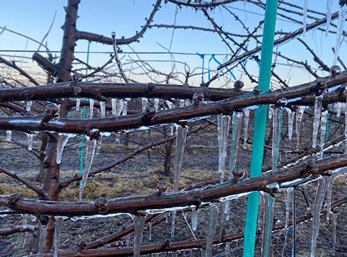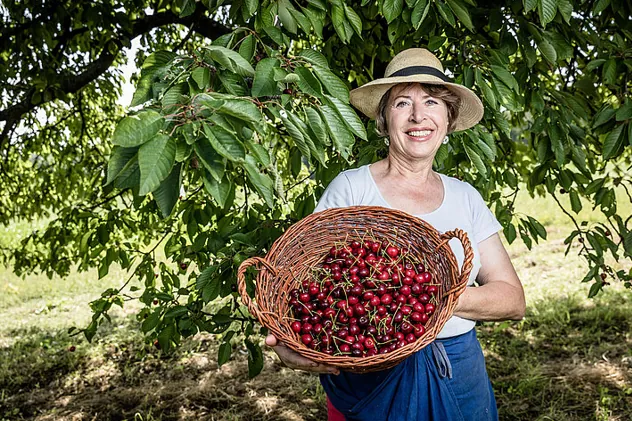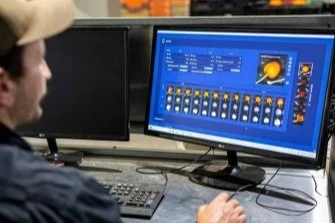This 2024 is influenced by the La Niña phenomenon: experts predict lower morning temperatures and below-average rainfall, which could affect agricultural activities this season.
When La Niña arrives, the minimum temperatures are lower than normal, and climate models predict that it will bring colder mornings, increasing the likelihood of frosts early in the harvest season for many crops.
The frosts that most concern producers are those below minus one, as they could negatively impact the yield of horticultural production.
It is worth noting that in 2013, there were polar frosts, and that year in particular, Chile lost more than 60 million boxes of fruit, so there is already experience and learning. Paula Santibáñez, an academic from the Climate Observatory at San Sebastián University, emphasizes that "September frosts could have a negative impact on fruit growing. Many fruit species are in the flowering season."
So, the buds are sprouting, and a frost below one degree can cause the bud to die, resulting in fewer fruits and a sharp drop in production."
Therefore, Santibáñez says, this season we need to be very attentive to forecasts because the likelihood of these events increases. "So far, we only have a probability. We can't even accurately estimate when this event might occur. It will depend a lot on activity, on anticipation, and we need to be very careful about this."
"In fact, in 2013, we had a frost on September 18, which caused a lot of damage in agriculture, and many lessons were learned from that frost, and we already know more or less which sectors are most prone to frosts. So, many farmers sometimes say: in this sector, we won't plant because it’s too risky, and there is prevention."
"In 2013, fruit trees in these areas were frozen. Therefore, it is often important, before planning a long-term investment, to understand the climate and risks of each sector," she adds.
It is essential to take care of fruit trees when they begin their vegetative activity; it is even recommended to delay the fertilization schedule. "For farmers who don't have frost control systems, it’s important not to anticipate operations, as there are products applied specifically to accelerate this process and thus extend the fruit's growth period."
"Therefore, these practices are not advisable at this time of year, especially with La Niña. Also, of course, using fertilizers too early can stimulate growth, the vigor of buds and shoots, making the buds more sensitive and accelerating their development, leaving them more exposed in case of frosts."
What is frost?
Frost is a meteorological phenomenon that involves a drop in ambient temperature below the freezing point of water, causing the water or vapor present in the air to freeze and deposit as ice on surfaces. More precisely, the World Meteorological Organization refers to ground frost, describing various types of ice cover on the ground produced by the direct deposition of water vapor.
In such situations, growers can adopt several alternatives to take care of their orchards, such as temperature controls, wind towers, coverings, application of water or irrigation before the frost without saturating the soil, use of heaters, micro-irrigation systems, or even helicopters to move the air above 10 meters to mitigate frosts down to minus 3 degrees.
Additionally, before frosts occur, protective or biological preparations for the soil and plants are applied; this is direct support for the plant itself, like taking vitamins before the arrival of winter or cold, as humans often do.
When asked how the arrival of “La Niña” in 2024 will affect farm frost planning and management, several actors in the agro-fruit sector responded to DiarioFruticola.cl.
The general manager of Agrícola Los Campos S.A., José Luis Leyton, in terms of preventive measures for this phenomenon in the cherry field, mentions that he has implemented the use of plastic covers to protect his crops from frost in spring, to keep the soil moist, and also to increase the area of cherry trees under these covers.
The use of plastic mulches ensures protection against fruit cracking and other benefits such as control of light frosts and reduction of radiation stress in summer. Additionally, early irrigation is planned due to the lower rainfall forecasted for these fields.
Leyton, when asked what technologies or innovative practices he considers essential to mitigate the impact of frost on agricultural production, responds that "if water is available, it will be the best frost control. It’s difficult to have sufficient water available at the time of early frosts. For me, the best control, and accessible if there is funding, is the use of fans with heaters for frost control."
Regarding examples of successful frost management that have led to a significant improvement in production at Agrícola Los Campos S.A., Leyton adds that maintaining soils with excellent moisture from the start and using covers with or without heaters have been of great help.
As for the impact on numbers or yield per hectare of production in the event of frosts, the director says it is very relative, as it depends on the degree or intensity of the frost and the stage of the tree’s phenological phase. “It can also be catastrophic when it comes to pears or apples during the fruit-setting stage, where a ring forms that completely damages the fruit. Then the loss can be total,” he explains.
Referring to whether growers are reactive or proactive in situations involving investments in crop protection, Leyton states that "there is a bit of everything. Those who have experienced a frost are now preparing in advance for the alerts of La Niña and possible frosts. Every day we have more information in advance and technologies that allow us to mitigate or anticipate the climatic phenomenon."
Turning to figures on the value of consulting services that a producer incurs to learn to manage production well, this consultant highlights that it costs between 20-30 UF. On the other hand, frost control in fields ranges from $20,000 per hectare to around $45,000 per hectare.

Physiological Effects of Frost on Plants
In plants, when the temperature is below 0 °C and there are substances acting as heterogeneous nucleators, water freezes, usually in the extracellular spaces where water freezes first. Inside the cells, the opposite is true, as their solute content is high, protecting them from freezing.
If temperature conditions persist or the temperature drops further, the vapor pressure of the ice will be lower than the vapor pressure of the liquid water.
As a result, the liquid water inside the cell will pass through the semipermeable membrane and deposit on the ice crystals outside the cell. When freezing occurs in plant tissues, cells die due to the loss of water from the cells to the extracellular ice masses.
If a plant cell lacks a heterogeneous nucleator, the temperature at which it would freeze is -40 °C. Generally, ice is extracellular in frozen leaves. According to Pearce, some of the substances that can act as heterogeneous nucleators are:
- Ice-nucleating active (INA) bacteria including: Pseudomonas syringae and Erwinia herbicola.
- Other biological molecules and structures.
- Organic or inorganic residues.
The most important aspect of frost in relation to plants is that it determines the length of the growing season: the period from the last killing frost in spring to the first killing frost in autumn, with reference to the tenderest cultivated plants.
There are regions where the season is critically short for the maturation of most usable crops, and others where the season is so long that more than one crop can be harvested. In regions where frosts are rare or non-existent, other factors become more important.
Agricultural consultants therefore emphasize that it is ideal to prepare crops strategically and preventively, ensuring production in advance, with technical tools or biotechnology, in order to safeguard business and ensure sustainability.
Frost Outlook for Chile's Central Valley
Adam Formica, scientific director of Sensonomic, when asked about the likelihood that La Niña will bring more frost this spring, responds that looking at the past, the total duration of cold events in September was longer when sea surface temperature anomalies were negative compared to today.
Over time, however, the duration of cold events has decreased, if they occur at all. This decrease is likely due to global warming. This does not mean that higher temperatures are without downsides. Fewer cool hours and more extreme summer heat create problems for producers, the expert explains.
For Formica, September is a critical time in Chile because cherry trees are in bloom. The flowers are very sensitive to frost, and cherries represent Chile's most valuable agricultural export, worth 3 billion dollars. Spring and summer temperatures can have a strong impact on the country's economy.
Regarding expert forecasts, “a relatively moderate La Niña event is expected to peak in December, with sea surface temperature anomalies of only -0.25 to -0.5°C. In comparison, the previous La Niña was expected to peak in December. The previous 2020-2023 La Niña peaked at about -1°C.”
The Solution Lies in Prevention: Bio-Preparations, Homeopathic Biodynamics
For over a decade, environmental phenomena and climatic disturbances have caused a series of severe losses in fruit and vegetable production in our country, leading to significant investments in costly and high environmental impact management systems and installations, due to the excessive use of energy and resources (gas, oil, electricity, water, extra labor, helicopters, etc.).
“The La Niña and El Niño phenomena lead to extreme temperature fluctuations, ranging from -3 to -5°C in winter or even more intense during many hours of exposure. Spring crops are physiologically vulnerable with temperatures fluctuating between 3°C and -3°C, conditions that have already become normalized during these months."
"La Niña has arrived, and with it the frosts that threaten the health and harvests of this season, and ThermoCare is a good ally in orchard protection. This innovative homeopathic biodynamic preparation prevents intracellular water from freezing and minimizes the damage caused by low temperatures. Don't let harsh weather affect your crops,” says Leonora Sepúlveda, founder and general manager of AgroCare Chile.
When asked how her company is approaching business and the demand for frost protection products, considering its focus on sustainable homeopathic solutions, Sepúlveda emphasized that “the company has already developed technical value proposals, based on cutting-edge biotechnology suitable for correcting and protecting crops during these periods of vulnerability, with efficient and harmless management for plants and the environment, for just over five years, with effective and successful results, bringing agribusiness to very positive profitability.”
With these environmental phenomena, production yields decline, but she explains a success story with one of her company's biodynamic homeopathic preparations ThermoCare®, a physiological thermoregulator for plants, which doubled the production of avocado trees in the Coquimbo region, Ovalle, “in María Pinto, for example, yields reached 100% of the performance compared to the previous season.”
"In the case of table grapes, in the critical areas of Rinconada de Los Andes, results in extreme conditions with frosts of up to -10°C saw more than 1000% of export-quality grapes harvested per hectare. Also in the Cerecera area, severe frosts during the budding, sprouting, and flowering periods were well controlled with ThermoCare®, achieving historic yields exceeding 35%.”
"Our clients have been seeking our 12 biopreparations for years because of the good results, technical support, and post-sales service we offer, along with technical consulting for each specific case, area, crop, surface, soil, and ecosystem. Additionally, our LSM Healing Remedies laboratory is equipped to meet any type of need, whether on a large or small scale."
Constant Monitoring and Temperature Management
Felipe Cáceres, General Director of TierraVerde, commented that “there is good preparation. Many farmers have temperature measurement systems or weather stations on their farms that notify them of temperatures or the likelihood of frost. For highly profitable crops, such as cherry trees, there are also pre-arranged contracts with helicopters for monitoring. There is a clear awareness of the high probability of this phenomenon occurring.
TierraVerde offers farmers two solutions. The first is based on the application of water to crops in a very small volume, using the "pulsator" as the key component. The energy to mitigate the damage is obtained from the water, so the farmer must have this element available safely and continuously.
A second available alternative is the use of electrofans with 30 Hp motors, which can protect against radiation frosts, i.e., when there is a temperature inversion or air temperature above 0°C at a height of about 9-15 meters. In addition, for winter frosts in the absence of thermal inversion, heaters can be added, with energy sourced from fossil fuels such as gas or oil.
TierraVerde is at the forefront of these technologies, which are based on low-water application. The investment, operation, and maintenance costs of this low-application solution are the lowest on the market, and its efficiency is the highest, says Cáceres.
The company’s equipment has been installed for many years on wine grapes in the Casablanca area in the Valparaiso region. In southern Chile, in the Los Angeles area, companies linked to the Zunino group have succeeded in their cherry tree cultivation, achieving production in areas severely affected by the cold.
When asked about the current state of the orchards, Cáceres said that “there are numerous success stories across the country. The last frosts in August had no repercussions on the crops, despite temperatures reaching -4°C.”
Source: Diario Frutícola
Image: Diario Frutícola; SL Fruit Service
Cherry Times - All rights reserved












